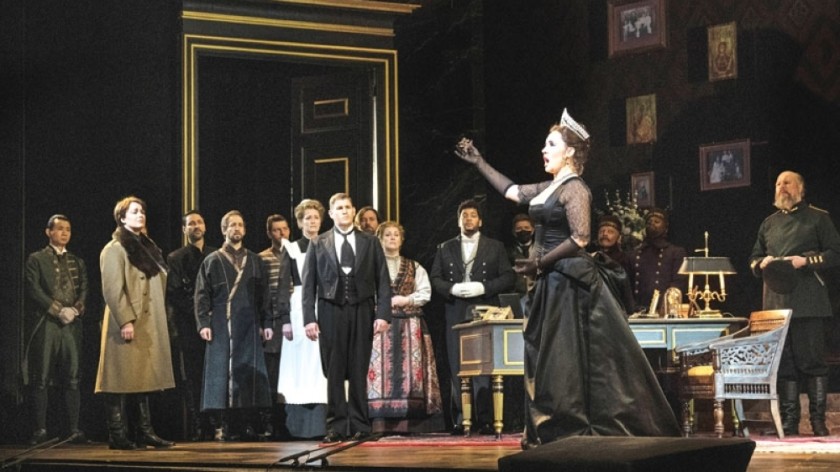

The mood was festive, the audience large and enthusiastic, for the gala premiere on New Year’s Eve of a rare new production of Umberto Giordano’s lovably preposterous potboiler “Fedora” at the Metropolitan Opera.
Soprano Sonya Yoncheva and tenor Piotr Beczala, playing aristocrats locked in a series of betrayals and counter-betrayals, passionately loved and raged; conductor Marco Armiliato and the Met’s orchestra brought restrained silkiness out of the pit; David McVicar’s staging was bustling and handsome. A good time was had by all.
But I couldn’t quiet a tiny voice of dread in me. Not about the celebratory scene on Saturday evening, but about what it will be like when the Met tries to get its money’s worth out of the new production and revives it, with far less marketing and press coverage and quite possibly a less starry cast. Who will be in the audience for that “Fedora” in a season or two or three?
The question has extra urgency after the coal that arrived in the Met’s stocking the day after Christmas, when the company announced that weak ticket sales and recalcitrant donors as the pandemic drags on would force it to raid its endowment to the tune of $30 million — a full tenth of the fund’s value — and to cut 10 per cent of its planned performances next season.
As a silver lining, the Met said at the same time that it would immediately expand its presentations of contemporary operas, which have been outselling some of the classics.

But in truth, what has been selling at the house is what gets promotional resources and media exposure: new productions, be they of brand-new pieces or 125-year-old ones like “Fedora.” Without that kind of publicity, attendance was particularly dire this fall for revivals of masterpieces that are hardly obscure but not quite “Aida,” like Mozart’s “Idomeneo,” Britten’s “Peter Grimes” and Verdi’s “Don Carlo.” This could very well be the fate of “Fedora,” too, when it’s brought back.
There is a real audience for the Met, as sold-out runs of “Fire Shut Up in My Bones” and “The Hours” have proved. Just not so much for a pillar of opera-going: hearing repertory pieces as they evolve, year in and year out, with different casts. It is, sad to say, an ever-smaller group of people who care to see “La Traviata” subtly but unmistakably transform with each new Violetta — or “Fedora” with each new Fedora.
That is why the 10 per cent trim in performances for next season is a portent of what’s to come. The Met’s long-term future may well consist of seasons with significantly fewer performances of significantly fewer titles, and a greater proportion of new stagings to returning productions.
That model, which would edge the Met closer to an annual event like the Salzburg Festival from its repertory-house tradition, may yield some strong artistic results. But the transition to it will involve a tumultuous rethinking of the company’s costs, and therefore its labour contracts, as well as fewer dismally selling revivals like this season’s “Idomeneo,” “Peter Grimes” and “Don Carlo” — all of which were excellent and all of which are integral to the Met’s responsibility to its art form.
Even if this “Fedora” is never revived, we will at least have had a sensitive, spirited run of a work that last came to the Met in the 1996-97 season, when it was a vehicle for the great diva Mirella Freni’s full-production farewell to the company.
“Fedora” is about as opera as opera gets. The title character (Yoncheva) is a Russian princess in the late 19th century who swears vengeance after her fiancé is shot to death. The plot, of course, thickens. It turns out that the killer, Count Loris Ipanov (Beczala), did not commit the crime for political reasons, as everyone assumed. (The dark spectre here, as in Dosteovsky’s “Demons” and the Coen brothers’ “The Big Lebowski,” is nihilists.) No, Fedora’s man was making it with Loris’ wife, setting off a jealous gunfight; once that is revealed, enmity between princess and count turns to lust.
This being a tear-jerker, their brief idyll is smashed when her prematurely sent letter of accusation inadvertently results in the death of Loris’ brother and mother, leading to his ferocious condemnation of Fedora and her overhasty suicide by the poison she keeps in a cross around her neck. (Don’t you?).
The play on which this dead-serious farrago is based was written by Victorien Sardou, the reigning French master of theatrical sensation, who was also the source for Puccini’s “Tosca” around the same time. Giordano, Puccini and other Italian composers who came of age in the 1880s and 1890s have become known to posterity under the catchall “verismo,” a term which came to suggest a style of sumptuous orchestral complexity and moment-by-moment emotional responsiveness, with arias and other numbers that emerge and recede organically rather than formally — at least compared with Italian opera as it had been before — but with a melodic lushness that set them apart from Wagner.
The gawkier sibling to its better-known predecessor, Giordano’s “Andrea Chénier,” “Fedora” is not a perfect piece. The roles other than Fedora and Loris are thoroughly unrewarding. The high spirits with which Giordano opens the second and third acts, for all-too-obvious contrast with the intense drama to come, drag on too long. — NYT
Oman Observer is now on the WhatsApp channel. Click here


